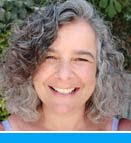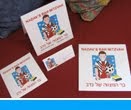Special sites in the forest include the Wildflower Trail, remains of ancient settlement and Izbet Sartah, which has been identified as the Biblical site of Even HaEzer. In the spring and autumn these points are excellent locations for observing migratory birds, whose flight path passes just overhead, and for seeing gorgeous wildflowers in bloom.

Mister Handmade in Israel and I visited the forest one recent weekend. Whilst there are very few flowers to be seen during the hot summer months, it was still beautiful. Carob, almond, Mount Atlas mastic tree (Pistacia atlantica), Jujube (Ziziphus spina-christi), Judas trees (Cercis siliquastrum), eucalyptus and cypress trees give variety and colour to the forest. In the spring a whole host of cyclamen, red and white anemones, tulips, bee orchids and asphodels can be seen amid the trees, interspersed with the leaves of sea squills, whose tall stalks bloom in autumn in many parts of the forest.
One section of the forest, in the east, is intended for walkers and cyclists only, and vehicles are forbidden there. We arrived on the marked road and then proceeded on foot on the red-marked "Wildflower Trail". This is a kilometre long circular trail, climbing up the hill to a small viewing point, before taking us back down to our starting point.
One section of the forest, in the east, is intended for walkers and cyclists only, and vehicles are forbidden there. We arrived on the marked road and then proceeded on foot on the red-marked "Wildflower Trail". This is a kilometre long circular trail, climbing up the hill to a small viewing point, before taking us back down to our starting point.
At the top of the hill we found the remains of an ancient settlement dating back originally to the Byzantine period, the Dayar Ruins, also known by the Arabic name of Khirbet ad-Dawir. The remnants of several buildings can still be seen, some of which have several courses of bricks intact. To the east of the site a square cistern has been hewn into the rock and plastered. A nearby JNF observation point offers excellent views of the entire region. To the east you can see the hills of Samaria and to the north the Arab city of Kafr Qasim and Highway 5, or the Trans-Samaria Motorway, one of Israel's main motorways.
From the Dayar Ruins we descended the marked path and joined up once again with the "Wildflower Trail". The path took us down the hill, walking on natural stone steps, until we reached our starting point once more.
Our next port of call was Even HaEzer Hill, below. This site is located in the western part of the Rosh HaAyin forest. We parked the car once again and entered the forest on foot. The Even HaEzer path began just near the road and took us all the way to the archaeological site. The path is indicated by posts marked in black. In the spring you can see narcissus, cyclamen, anemone and asphodel in the area.
We passed by the remains of Mahtzevet HaShezafim ("Jujube Tree Quarry"), which dates from the time of the British Mandate, and climbed to the top of the hill to the Even HaEzer site. This location, which is referred to today by the Arabic name Izbet Sartah (Izba in Arabic means small farm or village), has been identified as the Biblical site of Even HaEzer (the "Stone of Help" mentioned in 1 Samuel). The Even HaEzer area was the site of two important battles between the Israelites and the Philistines, one of which culminated in the capture of the Ark of the Covenant. In the second half of the 1970s excavations were carried out at the site and important artefacts were found from the First Bronze Age (the middle of the 12th century BCE).
The most important find at the site was an ostracon, a piece of pottery, usually broken off from a vase or other earthenware vessel, with writing on it, below. The inscription on the pottery was written by an unskilled scribe, probably a student, and it consists of four lines of writing exercises, followed by the 22 letters of the ancient Hebrew alphabet on the fifth line. This is one of the earliest Hebrew texts ever found and is now on display at The Eretz Israel Museum in Tel Aviv.
The remains of a 4-room house can still be seen on Even HaEzer Hill, surrounded by smaller houses and pits that were used as granaries for storing wheat and which were sealed off every winter to protect their contents from damage by rain. These early settlers lived off agriculture, raising goats and sheep and growing wheat. The structure of the building is typical of the Byzantine period.
The settlement probably supplied agriculture goods to the nearby city of Aphek, strategically located on a pass along the north-south Via Maris, the ancient road that connected the regions north of Israel (Mesopotamia, Asia minor and Syria) to the south (Egypt).
From the top of the hill we enjoyed wonderful views of the coastal plain and the Gush Dan area.
* This post has been shared on The Good. The Random. The Fun., Wordless Wednesday (on Tuesday), Sharon's Souvenirs, Our World Tuesday, Tuesday's Treasures, Pictorial Tuesday, Travel Tuesday and My Corner of the World.


















































































